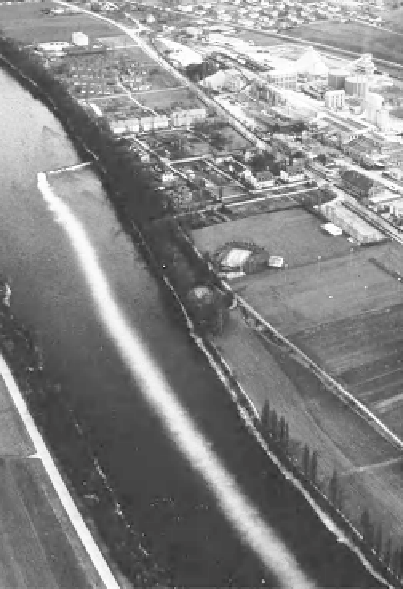Environmental Engineering Reference
In-Depth Information
tions. The discharge of oxygen-demanding substances
into rivers and streams causes a depletion of dissolved
oxygen (Do) downstream of the discharge location.
oxygen depletion can cause problems for aquatic life
and have a severe impact on the natural biota of a river
or stream. Sources of oxygen-demanding substances
include municipal and industrial wastewater, as well as
agricultural and urban runoff. nutrient pollution gener-
ally refers to elevated quantities of nitrogen and/or
phosphorus in the water. Excessive nutrients cause
increased plant and algae growth, resulting in reduced
oxygen levels and depleted populations of fish and other
desirable aquatic species. Municipal and industrial
wastewater discharges and runoff from agricultural
lands, forestry operations, and urban areas are major
nutrient sources. In the United States, the leading causes
of river and stream impairment are agricultural activi-
ties that include crop production and animal husbandry.
Treated sewage effluent, industrial wastewaters, and
stormwater runoff are discharged routinely into inland
streams. In cases where the wastewater discharges do
not meet the stream water-quality standards,
regulatory
mixing zones
are usually permitted in the vicinity of the
discharge location. Within these mixing zones, dilution
processes reduce the contaminant concentrations to
levels that meet the stream water-quality criteria. Waste
waters can be discharged into streams either through
multiport diffusers, which distribute the effluent over a
finite portion of the stream width, or through single-port
outfalls that discharge the effluent at a “point” in the
stream.
The case of a single-port discharge into a stream is
illustrated in Figure 4.1. In the immediate vicinity of the
discharge port, mixing of the pollutant is determined by
the momentum of the discharge, which occurs over
length scales on the order of the discharge-port diam-
eter. Further downstream, as the discharge is diluted,
the momentum of the discharge is dissipated, and
further mixing of the discharge plume is dominated by
ambient velocity variations in the stream. As the pollut-
ant cloud extends over the depth and width of the
stream, parts of the cloud expand into areas with signifi-
cantly different longitudinal mean velocities; the pollut-
ant cloud is then “stretched” apart in the longitudinal
direction in addition to diffusing in all three coordinate
directions. This stretching of the cloud is due primarily
to vertical and transverse variations in the longitudinal
mean velocity. The process of stretching is commonly
referred to as
shear dispersion
or simply
dispersion
.
Contaminant discharges from point sources spread in
the vertical and transverse directions by turbulent dif-
fusion until the pollutant is well mixed across the stream,
at which time almost all of the mixing will be caused by
longitudinal shear dispersion. Field measurements have
Figure 4.1.
Contaminant discharge into the Alpenrhein River
(Germany).
Source
: Socolofsky and Jirka (2005).
shown that in most cases, transverse variations in the
mean velocity (across the channel) have a much greater
effect on shear dispersion than vertical variations in the
mean velocity. Typical flow velocities in rivers and
streams are in the range of 0.1-1.5 m/s (0.3-5 ft/s), cor-
responding to channel slopes in the range of 0.02-1%.
4.2 TRANSPORT PROCESSES
In most cases, contaminants are introduced into rivers
over a particular subarea of the river cross section. For
example, pipe discharges are typically over a small area
along the side of the river, whereas submerged multi-
port diffuser discharges are over a larger portion of the
river cross section. In these cases, two distinct mixing
zones are identified: the initial mixing zone where the
contaminant mixes vertically and horizontally across
the cross section of the channel, and the well-mixed
zone, where the contaminant is well-mixed across the
cross section and further mixing is associated with lon-
gitudinal dispersion in the flow direction.
4.2.1
Initial Mixing
The turbulent velocity fluctuations in the vertical and
transverse directions in rivers are on the same order

Search WWH ::

Custom Search